
30 Results


This resource provides information about the careers in microbiology.
- Subject:
- Career and Technical Education
- Science
- Material Type:
- Reading
- Provider:
- National Oceanic and Atmospheric Administration (NOAA)
- Date Added:
- 12/01/2023

Read about Jules Bordet, the scientist awarded with the 1919 Nobel Prize in Medicine "for his discoveries relating to immunity." Site by the Nobel E-Museum.
- Subject:
- Health and Physical Education
- Material Type:
- Reading
- Provider:
- The Nobel Prize
- Date Added:
- 10/03/2023

A very complete biography from The Nobel Foundation on the man who was the father of modern microbiology, Robert Koch.
- Subject:
- Science
- Material Type:
- Reading
- Provider:
- The Nobel Prize
- Date Added:
- 10/03/2023
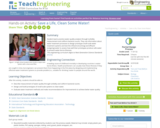
Student teams practice water quality analysis through turbidity measurement and coliform bacteria counts. They use information about water treatment processes to design prototype small-scale water treatment systems and test the influent (incoming) and effluent (outgoing) water to assess how well their prototypes produce safe water to prevent water-borne illnesses.
- Subject:
- Earth and Space Science
- Engineering
- Science
- Material Type:
- Activity/Lab
- Provider:
- TeachEngineering
- Provider Set:
- TeachEngineering
- Author:
- Christie Chatterley
- Denise W. Carlson
- Janet Yowell
- Malinda Schaefer Zarske
- Date Added:
- 09/18/2014

Spreadsheets Across the Curriculum module. Students build spreadsheets to calculate and compare bacterial population sizes from lab cultures in antibiotic-free and antibiotic-containing media.
- Subject:
- Life Science
- Mathematics
- Science
- Material Type:
- Activity/Lab
- Provider:
- Science Education Resource Center (SERC) at Carleton College
- Provider Set:
- Pedagogy in Action
- Author:
- Anton Weisstein
- Date Added:
- 02/24/2021
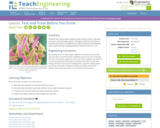
Students learn about water quality testing and basic water treatment processes and technology options. Biological, physical and chemical treatment processes are addressed, as well as physical and biological water quality testing, including testing for bacteria such as E. coli.
- Subject:
- Biology
- Chemistry
- Life Science
- Physical Science
- Science
- Material Type:
- Lesson
- Provider:
- TeachEngineering
- Provider Set:
- TeachEngineering
- Author:
- Christie Chatterley
- Denise W. Carlson
- Janet Yowell
- Kate Beggs
- Malinda Schaefer Zarske
- Date Added:
- 02/17/2021
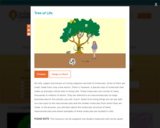
All cells, organs and tissues of a living organism are built of molecules. Some of them are small, made from only a few atoms. There is, however, a special class of molecules that make up and play critical roles in living cells. These molecules can consist of many thousands to millions of atoms. They are referred to as macromolecules (or large biomolecules).
- Subject:
- Biology
- Science
- Material Type:
- Activity/Lab
- Data Set
- Diagram/Illustration
- Interactive
- Provider:
- Concord Consortium
- Provider Set:
- Concord Consortium Collection
- Author:
- National Science Foundation
- The Concord Consortium
- Date Added:
- 08/18/2011
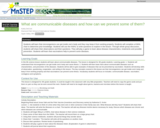
Students will learn that microorganisms can get inside one's body and they may keep it from working properly. Students will learn that vaccinations help to prevent some diseases but not others.
- Subject:
- Health
- Health and Physical Education
- Material Type:
- Activity/Lab
- Provider:
- Science Education Resource Center (SERC) at Carleton College
- Provider Set:
- Pedagogy in Action
- Author:
- Kathy DeCock
- Date Added:
- 02/24/2021
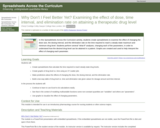
Spreadsheets across the Curriculum module. Students use a spreadsheet to build a two-way table of drug level vs. time and elimination rate with parameters dosage interval and amount.
- Subject:
- Chemistry
- Life Science
- Mathematics
- Science
- Material Type:
- Activity/Lab
- Provider:
- Science Education Resource Center (SERC) at Carleton College
- Provider Set:
- Pedagogy in Action
- Author:
- Cheryl Coolidge
- Date Added:
- 02/24/2021